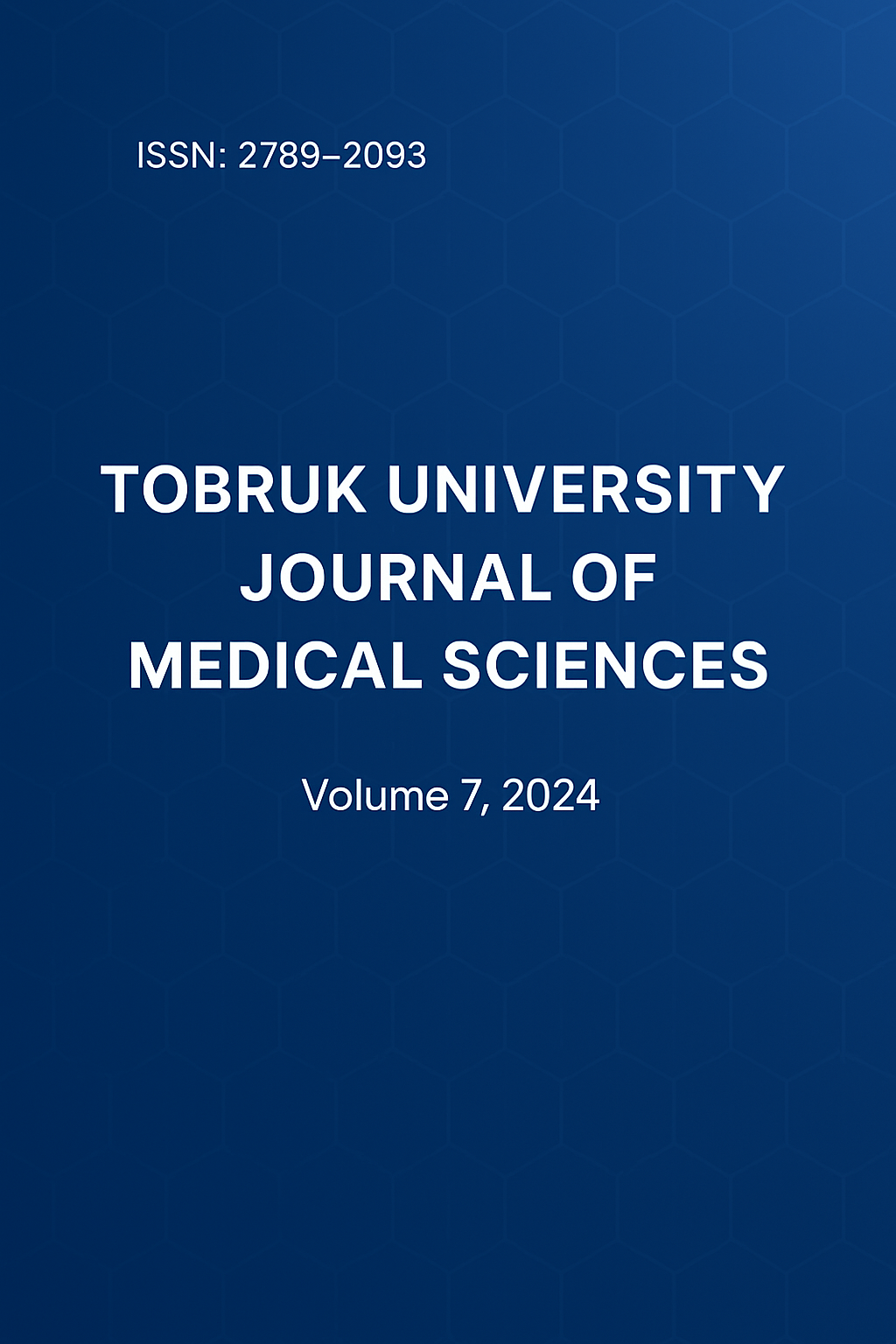Nutritional status among paediatric age group with chronic Renal failure undergoing hemodialysis.
DOI:
https://doi.org/10.64516/b7t2ht87Keywords:
nutritional assessment, children, hemodialysis, Tripoli.Abstract
Objective was to evaluate the nutritional status of 23 children with chronic kidney disease receiving hemodialysis. Methodology: A structured interview questionnaire was designed and used to interview the child or mother. It includes nutritional assessment of the children under study, such as physical examination, anthropometric measurements, and laboratory investigations. Results: The current study found that11 boys (47.8%) and 12 girls (52.2%), undergoing regular hemodialysis. Age ranged from 1 to 14 years.73.9% had family history of hemodialysis, 95.7 % from the participants the duration of hemodialysis was 4 weeks and 73.9% from patients follow CKD and the majority of children under 90% of age and gender criteria had below normal weight, arm circumference, and triceps subcutaneous fat thickness and the average upper-to-lower body ratio was 1.1 and the average arm span-to-height ratio was 1, indicating proportional short stature in CKD Related to the clinical and laboratory characteristics of children with CKD. protein intake was significantly positively correlated with BUN, significantly negatively correlated with serum bicarbonate levels, the minimum albumin value was 3.0 mg/dl, and the maximum value was 7.1 mg/dl. Conclusion: In conclusion the age ranged from 1- 14 years,73.9% of patients follow CKD and many children (90%) of children had below normal weight and the average albumin value was 3.0-7.1 mg/dl. Therefore, nutritional assessment should be based on multiple methods, the results of which should be synthesized by a pediatric nephrology team to comprehensively assess how dialysis start date is associated with lower anthropometric measurements. Improving parental knowledge of nutritional dialysis is important.
References
1-Blumberg Benyamini S, Katzir Z, Biro A, Cernes R, Shalev B, Chaimy T, Barnea Z. Nutrition assessment and risk prediction in dialysis patients-a new integrative score. J Ren Nutr. 2014;24:401–410.
2-Edefonti A, Mastrangelo A, Paglialonga F. Assessment and monitoring of nutrition status in pediatric peritoneal dialysis 26 patients. Perit Dial Int 2009;29:176–9.
3-Elshafie AM, Bahbah MH, Elnemr FM, et al. Effect of omega-3 supplementation on lipid profile and inflammatory markers in children on chronic hemodialysis. Menoufia Med J 2016;29:265
4-Goodkin, D. A., Bragg-Gresham, J. L., Koenig, K. G., Wolfe, R. A., Akiba, T., Andreucci, V. E., ... & Held, P. J. (2003). Association of comorbid conditions and mortality in hemodialysis patients in Europe, Japan, and the United States: The Dialysis Outcomes and Practice Patterns Study (DOPPS). Journal of the American Society of Nephrology, 14(12), 3270-3277.
5-Hou Y, Li X, Hong D, et al. Comparison of different as-assessments for evaluating malnutrition in Chinese patients with end- stage renal disease with maintenance hemodialysis-sis. Nutr Res 2012; 32:266– 271.
6- Hurley, K.M.; Yousafzai, A.K.; Lopez-Boo, F. Early Child Development and Nutrition: A Review of the Benefits and Challenges of Implementing Integrated Interventions. Adv. Nutr. 2016, 7, 357–363. [CrossRef]
7- Hanan Abdulqaium et.al. Nutrition assessment and management in children on peritoneal dialysis in Nephrology and dialysis unite in Tripoli University Hospital in Libya. Journal of the Arab Board of Health Specializations A Medical Journal Encompassing all Health Specializations Issued Quarterly SELECTED ABSTRACTS CONTENTS JABHS Vol. 18, No. 3, 2017.
8-Ikizler TA, Cano NJ, Franch H, Fouque D, Himmelfarb J, Kalantar-Zadeh K, Kuhlmann MK, Stenvinkel P, TerWee P, Teta D, Wang AY, Wanner C International Society of Renal Nutrition and Metabolism. Prevention and treatment of protein energy wasting in chronic kidney disease patients: a consensus statement by the International Society of Renal Nutrition and Metabolism. Kidney Int. 2013;84:1096– 1107.
9-Kovesdy, C.P.; Kopple, J.D.; Kalantar- Zadeh, K. Management of protein-energy wasting in non-dialysis-dependent chronic kidney disease: Reconciling low protein intake with nutritional therapy. Am. J. Clin. Nutr. 2013, 97, 1163–1177. [CrossRef] [PubMed]
10-Kulkarni MJ, Jamale T, Hase NK, et al. A cross-sectional study of dialysis practice- patterns in patients with chronic kidney disease on maintenance hemodialysis. Saudi J Kidney Dis Transpl 2015;26:1050-6.
11-Kim H, Lim H, Choue R. A better diet quality is attributable to adequate energy intake in hemodialysis patients. Clin NutrRes. 2015;4:46–55.
12-Kang SS, Chang JW, Park Y. Nutritional status predicts 10-year mortality in patients with end-stage renal disease on hemodialysis. Nutrients. 2017;9:e399.
13-Lesley Rees & Vanessa Shaw. Nutrition in children with CRF and on dialysis. Pediatric Nephrol (2007) 22:1689–1702 DOI 10.1007/s00467-006- 0279-z.
14-ŁukaszykE., ŁukaszykM., Koc- ŻórawskaE.. Iron status and inflammation in early stages of chronic kidney disease. Kidney Blood Press Res. 2015; 40(4): 366–373
15-Lotfy HM, Sabry SM, Ghobrial EE, Abed SA. The effect of regular hemodialysis on the nutritional status of children with end-stage renal disease. Saudi J Kidney Dis Transpl 2015;26:263- 70.
16-Moushira Erfan Zaki & Mona Mamdouh Hassan et.al in Egypt, Nutritional Status in Children with Chronic Renal Failure on Hemodialysis Macedonian Journalof Medical Sciences. 2012 Oct15;5(3):296-301.
17- Maryam Mohammad. Assessment of Nutritional Status of Children with Chronic Renal Failure Undergoing Hemodialysis. 27 Tanta Scientific Nursing Journal · February 2020
18-National Kidney Foundation. Kidney Disease Outcome Quality Initiative (NKF- K/DOQI) Clinical practice guideline for nutrition in CRF. Am J Kidney Dis 2000;35 (Suppl 2):S1-40.
19-National Kidney Foundation Kidney Disease Outcomes Quality Initiative. KDOQI clinical practice guideline for nutrition in children with CKD: 2008. Am J Kidney Dis. 2009; 53(3): S1– S124.
20-Nazar CM, Anderson J. Extent of malnutrition in end-stage renal disease patients. J Nephropharmacol. 2014;3:27–28.
21-Nutrition for Your Child on Peritoneal Dialysis. Available online: https://www.niddk.nih.gov/healthinformati on /kidney-disease/children/caring-child- kidney-disease/nutrition-chronic-kidney- disease# nutrition (accessed on 18 April 2020).
22-Pupim LB, Cuppari L. Malnutrition in end-stage renal disease: beyond inadequate nutrient intake. Nephrol News Issues. 2003;17:66–71.
Pisoni RL, Bragg-Gresham JL, Young EW, et al. Anemia management and outcomes from 12 countries in the dialysis outcomes and practice patterns study (DOPPS). Am J Kidney Dis 2004;44:94-111.
23-Santos NS, Draibe SA, Kamimura MA, Canziani ME, Cendoroglo M, Junior AG, Cuppari L. Is serum albumin a marker of nutritional status in hemodialysis patients without evidence of inflammation? Artificial Organs.2003;27(8):681-686.
24-Souza RA, Oliveira EA, Silva JM, Lima EM. Hemodialysis vascular access in children and adolescents: A ten-year retrospective cohort study. J Bras Nefrol 2011;33:422-30.
25-S. A. Abed, “Assessment of the Nutritional Status of Pediatric Patients on Regular Hemodialysis by Lecturer of Pediatrics”.Shapiro BB, Bross R,
Morrison G, Kalantar-Zadeh K, Kopple JD. Self-reported interview- assisted diet records underreport energy intake in maintenance hemodialysis patients. J Ren Nutr. 2015;25:357–363.
26-Satirapoj, B.; Limwannata, P.; Kleebchaiyaphum, C.; Prapakorn, J.; Yatinan, U.; Chotsriluecha, S.; Supasyndh, O. Nutritional status among peritoneal dialysis patients after
oral supplement with ONCE dialyze formula. Int. J. Nephrol. Renov. Dis. 2017, 10, 145–151. [CrossRef] [PubMed].
27-Wong CS, Gipson DS, Gillen DL, Emerson S, Koepsell T, Sherrard DJ, Watkins SL, Stehman-Breen C (2000) Anthropometric measures and risk of death in children with end-stage renal disease. Am J Kidney Dis 36:811.
28- Walters, B. A., Hays, R. D., Spritzer, K. L., Fridman, M., & Carter, W. B. (2002). Health-related quality of life, depressive symptoms, anemia, and malnutrition at hemodialysis initiation. American Journal of Kidney Diseases, 40(6), 1185-1194.
29- Wingen AM and Mehls O (2020). Nutrition in children with preterminal chronic renal failure. Myth or important therapeutic aid? Pediatric Nephrol; 17:111–120
30--.ZaritskyJ., YoungB., WangH.J.. Hepcidin—a potential novel biomarker for iron status in chronic kidney disease. Clin J Am Soc Nephrol. 2009; 4(6): 1051–1056.
Downloads
Published
Issue
Section
License
Copyright (c) 2024 Amal R. Agila, Ambarka Eid.H Kreim (Author)

This work is licensed under a Creative Commons Attribution 4.0 International License.











